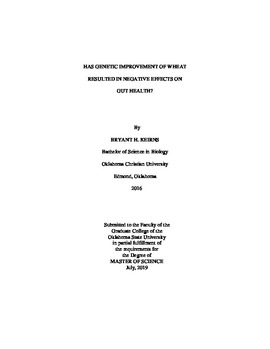| dc.contributor.advisor | Smith, Brenda J. | |
| dc.contributor.author | Keirns, Bryant H. | |
| dc.date.accessioned | 2020-01-30T19:46:41Z | |
| dc.date.available | 2020-01-30T19:46:41Z | |
| dc.date.issued | 2019-07 | |
| dc.identifier.uri | https://hdl.handle.net/11244/323405 | |
| dc.description.abstract | Objectives: Wheat consumption has recently declined amid growing concerns about gluten-sensitivity. To determine if genetic manipulation of wheat contributes to gut inflammation, we investigated the effects of modern and heirloom wheat on gut health under normal and western diet (WD) conditions. | |
| dc.description.abstract | Methods: 6-week, C57BL/6 male mice were utilized in a 2x3 factorial with diet (control [AIN-93G] or WD, 45% fat and high sucrose) and wheat flour (no wheat, 10% heirloom [Turkey] or 10% modern [Gallagher]) as factors. After 6-weeks, body composition was assessed, and tissues were collected to evaluate metabolic parameters, systemic and intestinal indicators of inflammation, structural changes in different regions of the intestine and gut barrier integrity. Additionally, cecal short-chain fatty acids (SCFAs) were assessed. Data were analyzed using 2-way ANOVA (SAS, Version 9.4) unless tests of normality failed, in which case Friedman's test was performed. Fischer's least square means was run for post-hoc analysis. | |
| dc.description.abstract | Results: Body weight, % fat, fasting glucose, total cholesterol, and NEFA were increased with WD and wheat did not affect these parameters. Serum C-reactive protein (hsCRP) and lipopolysaccharide binding protein (LPS BP) were unchanged by WD or wheat. WD decreased the SCFA, acetic acid, but adding Gallagher to WD restored levels to control (PWD*Wheat<0.05). No other SCFA were altered. Histological evaluation revealed reduced villi height (P<0.05) and area (P<0.05) in the jejunum with WD and wheat did not alter this response. Within the ileum, Gallagher increased villi area (P<0.01) relative to control; no other changes were noted. No effects of WD or wheat on crypt hyperplasia, lymphocyte infiltration, or goblet cell number within the jejunum, ileum or colon were observed. Overall, gene and protein abundance of tight junction proteins were unaffected by WD or wheat, except for a reduction in junction adhesion molecule-3 (JAM-3) with WD+T (P <0.05). Within the ileum lamina propria, WD increased interferon-γ (IFN-γ) (P<0.05). Adding Turkey suppressed interleukin-17 (IL-17) (PWD*Wheat<0.05) within the context of WD. No other inflammatory cytokines (i.e., tumor necrosis factor-α [TNF-α], IFN-γ, or IL-6) were altered by wheat. | |
| dc.description.abstract | Conclusion: These findings indicate Gallagher did not compromise barrier function or contribute to gut inflammation relative to Turkey. | |
| dc.format | application/pdf | |
| dc.language | en_US | |
| dc.rights | Copyright is held by the author who has granted the Oklahoma State University Library the non-exclusive right to share this material in its institutional repository. Contact Digital Library Services at lib-dls@okstate.edu or 405-744-9161 for the permission policy on the use, reproduction or distribution of this material. | |
| dc.title | Has Genetic Improvement of Wheat Resulted in Negative Effects on Gut Health? | |
| dc.contributor.committeeMember | Lucas, Edralin | |
| dc.contributor.committeeMember | Lin, Dingbo | |
| osu.filename | Keirns_okstate_0664M_16351.pdf | |
| osu.accesstype | Open Access | |
| dc.type.genre | Thesis | |
| dc.type.material | Text | |
| dc.subject.keywords | gut | |
| dc.subject.keywords | heirloom | |
| dc.subject.keywords | inflammation | |
| dc.subject.keywords | modern | |
| dc.subject.keywords | wheat | |
| thesis.degree.discipline | Nutritional Sciences | |
| thesis.degree.grantor | Oklahoma State University | |
